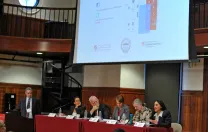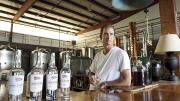"Reimagining the City-University Connection," a symposium held October 21 at the Radcliffe Institute for Advanced Study, highlighted many examples of community partnerships involving Harvard faculty and programs. These included work by:
- Anthony Braga, senior research fellow in the Harvard Kennedy School (HKS) Program in Criminal Justice Policy and Management and a professor in the School of Criminal Justice at Rutgers, with the Boston Police Department. Working with Daniel Linskey, superintendent-in-chief of the police force, to identify “hotspots” for violence within the city, Braga found that just 5 percent of the city’s three-block areas accounted for 74 percent of violent crimes during the previous 28 years. Braga’s analysis gave Linskey a sense of where to focus resources. In a pilot program of community policing in some of these “hotspots,” officers were permanently assigned to these neighborhoods instead of rotating through on shifts, and were able to form relationships with residents and business owners, resulting in a 17 percent reduction in violent crime compared to “hotspots” that were not part of the pilot.
- Felton Earls, professor of human behavior and development at the Harvard School of Public Health and professor of social medicine at Harvard Medical School. Earls developed the concept of collective efficacy, a measure of the strength of community and one’s trust in one’s neighbors. Earls studied collective efficacy’s relationship to crime rates in Chicago, and more recently, translated the collective efficacy model for work on HIV prevention in Tanzania. He sees parallels between violence, which can spread like a disease, and an actual disease; and HIV in Tanzania and violence in urban America, he says, are equally urgent problems in their respective communities.
- Sarah Glover, executive director of the Strategic Data Project at the Graduate School of Education’s Center for Educational Policy and Research. The center aims “to transform the use of data in education to improve student achievement.” To that end, it has helped school districts see, for example, that students who are less skilled at math are often placed with novice teachers. Administrators often realize that this trend exists across the U.S. education system and even within districts, but seldom believe it’s true within individual schools until they see the numbers, Glover said. Among other things, the project also helps school systems see (and, consequently, address) the large variation from district to district in the percentage of high-achieving students who go on to attend college.
- Graham professor of education Catherine Snow, director of research in Boston for the Strategic Education Research Partnership, who worked with Boston school administrators and teachers to develop a literacy program for middle-school students who lacked basic vocabulary knowledge. For example, Snow said, “It’s hard to teach kids that photosynthesis is the process of converting solar energy into nutritional energy when they don’t know what process means and they don’t know what convert means.” The same intervention is being formally evaluated in Baltimore, Pittsburgh, and San Francisco.
- public policy fellows program at the HKS Rappaport Institute for Greater Boston. Fellows have worked on issues including urban agriculture, school reform, environmental risk assessment, racial bias in the juvenile justice system, and much more.
- the Public Education Leadership Project, a joint initiative of the Graduate School of Education and Harvard Business School that has partnered with 15 urban school districts including Boston (and was praised by Boston Public Schools superintendent Carol R. Johnson at the symposium).
- and Katharine Lusk, an HKS master’s degree student. Working as a summer fellow in the office of Boston Mayor Thomas M. Menino, Lusk developed a financial literacy program for high-school students that included an educational component; a project to create student-run credit unions in schools; and an effort to bring banks into compliance with a state law that requires they provide low- or no-fee checking and savings accounts for youths 18 and under.





